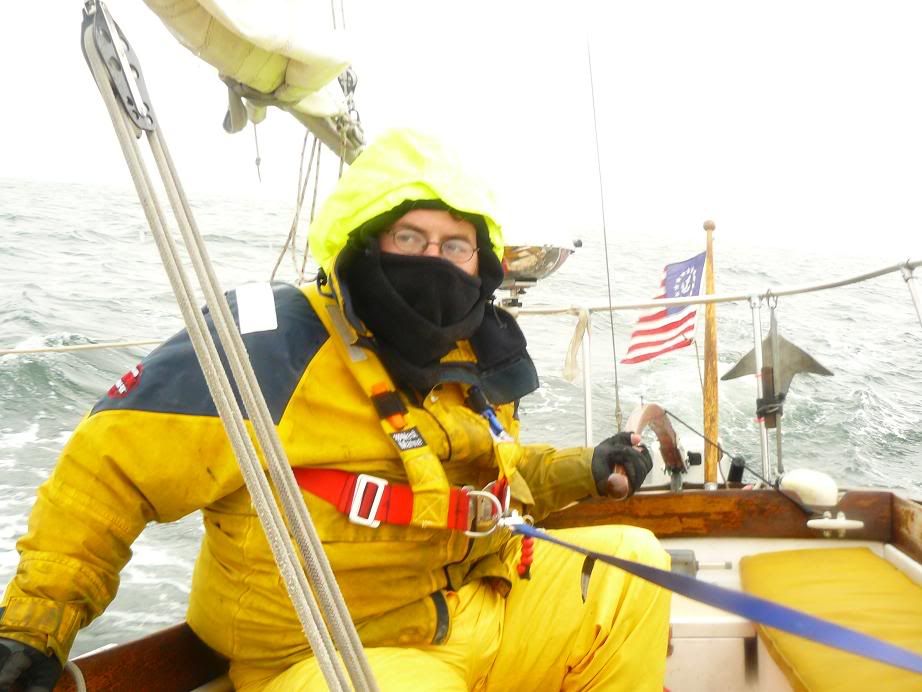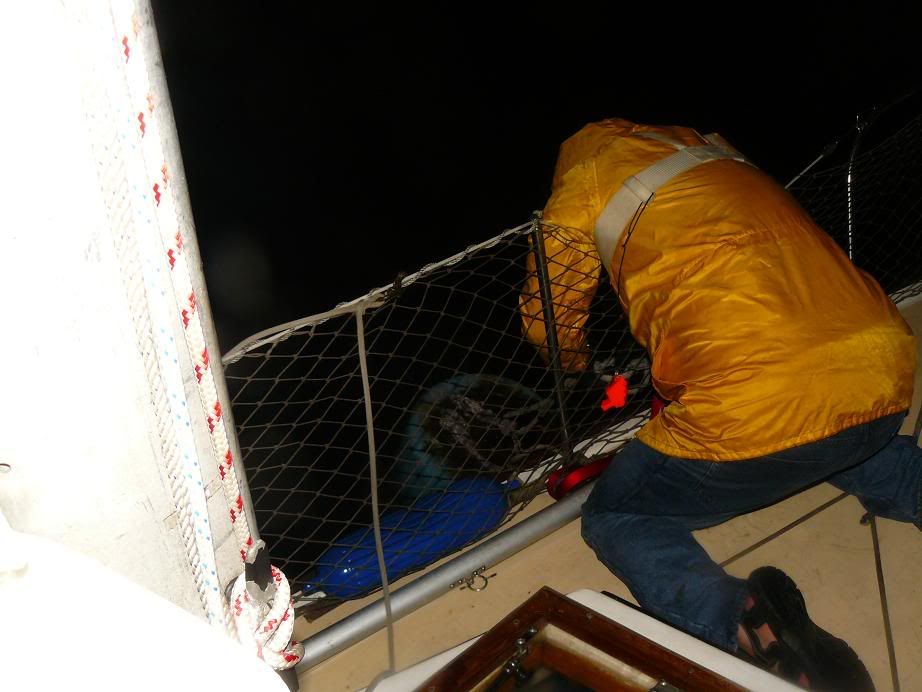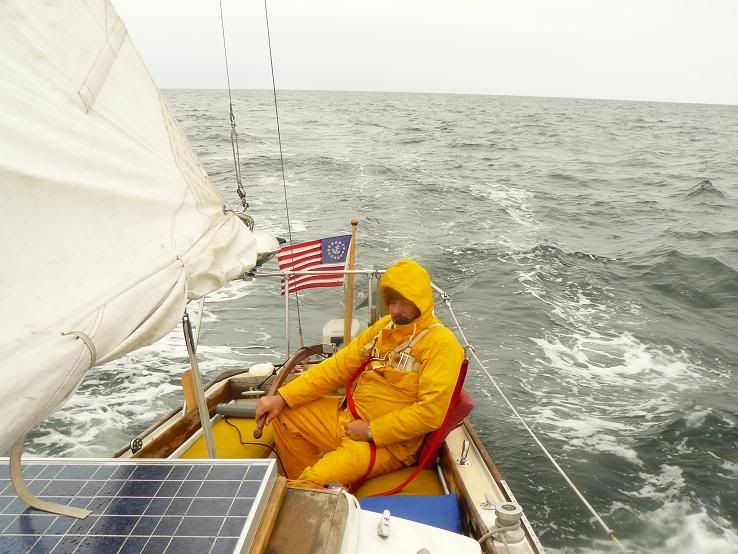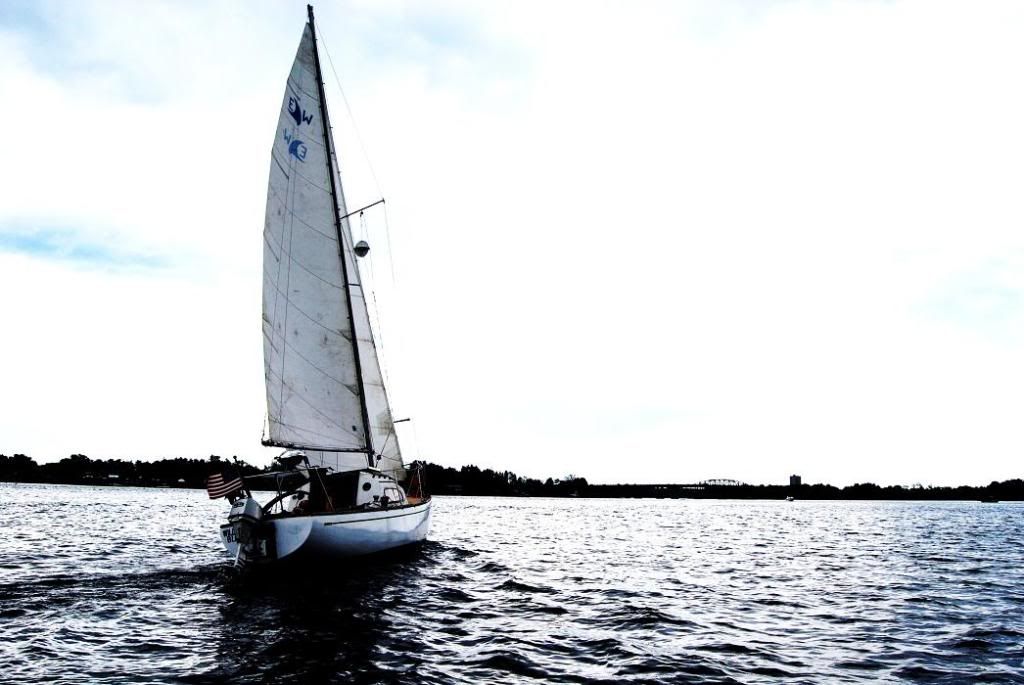The Account of the Voyage from Portland to PortsmouthA Story by Robin - Scott JohnsonFrom the logs of s/v William Bligh, the skipper gives the account of the sailing voyage down the Eastern Seaboard from Portland, Maine to Portsmouth, New Hampshire.
The Account of the Voyage from From the Logs of the s/v William Bligh, transcribed by Robin Scott Johnson, BN. Vessel: s/v William Bligh: 1971 Paceship East Wind ( Crew: Skipper: Robin Scott Johnson (b. 1976 The Beginning… 26 May 2009 The large round headlamps on my silver Japanese four-wheel drive, the one that looked as though it would be more at home in the jungle than parked on pavement at a boatyard, met the morning seemingly saluting the presence of the red bottomed full keeled sloop that stood on a cradle next to it in the early morning Portland fog. The vessel was s/v William Bligh, and today, she would finally sail from Dawn was breaking, and already the Sun was endeavoring to burn a hole through the sticky fog of the eastern horizon like a welding torch through butter. It was going to be a hot one—well, hot for I shook the shackles of my repose and pulled a shirt on before climbing out of the Bligh’s small salon, out into the cockpit, and carefully braving the ladder down to the cement, seven feet or so below. The very act of using a ladder still brought me tremendous fear, after breaking my right leg when a ladder broke on me, several months and thousands of miles away in a s****y corner of
Two long hours later the office had opened and had told me that they’d have my boat in the water at high tide, which was around 1300, if I recall. I drove my vehicle up to
At 1300, the pretty and classic lines of s/v Bligh slipped into the inky blue water at Portland Yacht Services and was skillfully towed around to the wharf where she was tied up while Brian and I finished loading her with supplies and I warmed up and tested the Honda and burned off some of the year-old fuel in her tanks. At 1615 shoved off, motor on, letting Brian stay at the helm to keep us on course while I raised the sails. I first hoisted the headsail, a yankee cut jib, with ease, and tied the halyard to the starboard mast cleat, then I moved to the mainsail, which I knew would be a bit tougher with the wind hitting us from the south. I told Brian to turn a bit more into the wind so we were nearly in irons, and cranked the halyard around the mast winch, which I found would only take a pitiful amount of stress before slipping on its gears… the damned thing was stripped! How had I not caught this before now? Well, probably because this was the first time I’d used the halyard winch, as the only other time I’d sailed the Paceship was a year ago in very light winds. Brian came up to the mast and we both were able to tug the halyard enough to raise the main. Mark one for the first thing I’ve got to replace on this old boat.
We sailed swiftly out of Portland Harbour between Cushing Island and the mainland, it was all very beautiful and clichéshly Mainey: The old forts to port, the light houses, the smell of the sea, rustic houses on the tops of jagged horrific cliffs with the ocean crashing down below. Even after killing the motor we were making 6.3 knots, and I felt we could be in Having resumed the helm, I continued to sail ESE for nine miles, even as I noticed the winds were going to be a problem,, as they blew from the south. Tacking to the SW the seas became rougher, with four foot swells, and the occasional six foot wave on top of them, with several hitting us on the bow’s port side sending water high over the boat and into the cockpit. Brian and I changed into our foul weather gear, even though it was clear, and resumed our fight south, which had slowed to 4.2 knots as the waves and wind all beat north. Brian soon found that his garage sale foul weather was not as waterproof as it should have been, in fact he described it was sitting inside a sieve, and was soon soaked to the bone and very cold. The temperature began dropping, into the high forties, and I decided we’d find a cove to anchor in for the night. I knew there was a jetty of something connecting The small , shallow cove behind
Down below I sat on the quarterberth, condensation dripping down on my head, comforting my seasick cat. Brian climbed up into the v-berth to find it was very wet. I gave him a 6X8 tarp to cover it with, so he wouldn’t have to sleep on cold, moist cushions. Before going to sleep I set the drag alarm just in case to 8’. 1240AM. The anchor drag alarm beeped quietly and I awoke with a start. We were too close to the rocks for us to be set adrift in the cove, and wind was against the shore, so we’d be smashed on the rocks of our line broke or the mooring was dragging. I was so tired though. I yelled for Brian to check it. He replied that he thought we were fine… but I persisted, reminding him that he was on watch until 0300, and to please go up above and check out the situation. He didn’t protest and did so, but I felt a little bad, perhaps I should have done it myself, although if he’d refused on this occasion I would have done just that. Still, a watch is a watch, whether we’re in port or not, and I think I handled the situation calmly, politely, and with the proper level of assertiveness and authority (barring that, as I said, I would have checked if he’d declined and found some friendly way of discussing the skipper/crew relationship the following day.) You know, we had agreed to the watch schedule on the way to Maine, and he hadn’t brought up any issues with it, so I assume he was just half asleep… regardless, he hasn’t brought up the matter again. 5/27: 0545: I awoke and immediately checked the mooring and our position. The anchor alarm had sounded four or five more times in the night, and looking at our track, it had seemed we had gone up and down with the tide, which was now low, and changed position greater than eight feet due to the current changing. Obviously this was to be expected in the Fisherman were starting up their boats around us, some of them had already left the cove. Some waved sleepily at me as I listened to the coffee percolate in the kettle and Lava ate out of his bowl in the cockpit. Brian slept for anther hour, while I checked the boat. Most of the sail ties were lost, having been blown overboard in their bag. Searching around, I still had enough, albeit, the bare minimum, I’d have to order some more when I got to shore. I watched the Sun rise and I woke Brian, as it was time to leave, and I wanted to beat the tide. 0645: Brian hoisted the sails, and with the Honda motor running, we departed back to the east to circle around Richmond Island, Maine, setting a course for ESE for several miles so as to allow us to tack more conservatory into the wind, which one again was from the south…. Bugger. Just to the east of The weather on the 27th was unpredictable from the start. It began partly cloudly, but soon the wind picked up nicely, and large fluffy clouds merged all it once and it began to rain. It rained and rained, and rained some more, and the wind began shifting a bit from the south east. The glass was dropping and I could tell that we were approaching a low of some kind. Still it rained, and the wind continued to shift all up until afternoon when we got a slight break. I noticed a few large cans floating a mile or so off shore. Upon closer inspection they said, “SECURITY ZONE.” I looked ashore and saw several large mansions, one of which, I assume was the former President George HW Bush’s summer retreat. I am almost confident of this. We were near Kennybunkport, and it was when I noted this in my logs while lying below the Honda engine, which I’d been running at a quarter throttle while under full main and reefable genoa against the wind, quit. I had been down below trying to rest on my break when it happened. I came up to see Brian eyeing the speed on the GPS… he told me we were down to 3 knots against the wind without the motor. I tried to get it going, and eventually gave up. It didn’t work. Something had gone horribly wrong and I knew nothing about outboards, I was terrified by the prospect of something going wrong, and now something had, I didn’t even have a Honda manual. Telephoning my friend Jay from Paceship.org who had some experience with the motor, I explained to him what had happened. He listened and told me that at some point the motor had been stored incorrectly, and that a quick fix would be to take the carburetor completely apart and let it sit overnight in a carb kit. Additionally, I was supposed to replace all the fuel lines, the tank, and add an inline fuel filter somewhere along the new fuel line. To do this I’d need to find a port for a day or two, and Kennybunk was now no longer an option, nor was York Harbour, as I was warned that without a motor it would be too tough due to the extreme currents that exist in New England river harbours. God I miss California and her man made jetties and calm deep harbours…
Brian remained at the helm, soaked to the bone in his defective foul weather gear, telling me that although he was miserable, he was glad he was there. His hands were like prunes, so saturated was their flesh. So were mine, but I couldn’t remain at the helm and stay on the phone trying to figure out what to do. My BoatUS membership had lapsed, but I figured that if I renewed it I could sail into the mouth of the harbour and call TowAssist for help… but even as I was about to pay the lady from BoatUS 187 or whatever it was for the unlimited towing, she told me it wouldn’t take effect for 24 hours. What the hell.. if I get auto insurance with tow coverage and drive off a car dealer’s lot and break down.. they’ll tow me the same day… I mean, why is doing this on the water so much bloody trouble? It’s greed, that’s what it is, greed, like most of the people in the boat business. It’s the same reason one of those sea steps, you know, the kind where it’s just one metal step and a couple of chains is 300+ dollars. So that wasn’t going to work. Still two hours from the harbour at 1.5 knots with the wind getting very shifty, and I knew we wouldn’t make it by nightfall. Returning to the Honda I pulled the choke and tried pulling the flywheel again, it fired up…. And remained running. I through it in gear and cranked the throttle on high and we were able to motor sail quickly at 7 knots to Jaffrey’s Point… then we slowed as the water was flat as glass and we played the “avoid the shoals” game again. We spotted the mooring field at 2100… darkness had fallen enveloped us, as Brian and I traversed the long gangway to the large house with the 1632 marker, indicating that it was nearly four hundred years old. We knocked at the door, but no one came, yet all of the lights were on. We walked out the little white gate and began down the lane, passing the house on our right. I noticed a woman, a little girl, and a dog watching TV through the open window on the far side of the house.. Upon seeing this, we turned around and returned to the door, giving it a police-style BANG BANG BANG knock on it’s heavy wooden surface. A thin young woman came to the door and greeted us, asking if we were the ones at the dock. I apologized right out, and explained our problem with the motor, to which she invited us in for a cup of hot coffee and explained that the dock and moorings were managed by a state representative of We thanked her and returned to the boat, where I promptly checked the tide table and depth sounder: another half hour to go until low tide, about a foot.. but only 2 feet under the boat…. Hopefully the harbour was calm, or we’d be hitting the rocky bottom with our keel! 28 May 2009 The next morning we rose early to heavy rain, but no matter, there was work to be done. We had to get into First the man, whose name was Kevin and worked as a carpenter, drove us to the auto parts store where I got a carb kit, which is basically a paint can with a basket inside and a powerful, horribly toxic venim which cleans a carburetor body and melts away any petroleum based thins like gelled fuel or plastic parts which you might have forgotten to remove. Next we visited West Marine and I purchased a new fuel line, filter, gas tank, but they didn’t have the Honda connector, so that would be the only part of the fuel system we’d have to re-use. Lastly, Kevin drove us into I took the opportunity to stop by the post office and send a cheque to my ungrateful roommate in We returned to the boat and sat inside, checking our e-mail while the rain drummed down on the decks above… Later on, I walked over to David Borden’s house and talked to him about our situation, expecting to have to pay a great bill… brought my wallet with me. Borden is a Democrat Rep for Rockingham in the State House. According to his neighbours, he is very much an environmentalist, chastising his neighbours for using gas mowers on their lawns, insisting they use an old fashion push mower. Remember this last sentence… Mr. Borden, however, did not ask me for a penny for the dock space or for a mooring, letting me know I was welcome to stay and make repairs, and suggested a mooring for us to tie onto when we got the motor going. He was very, very accommodating, and this really helped bring my stress level down a few notches. 29 May 2009 Rain.. well, regardless of what the weather was doing, I had to get to the carburetor. I suited up in my foul weather gear, climed in the zodiac with my tool bag, and tied the dinghy to the stern, where I began the task of removing the carburetor. The task didn’t take as long as I expected, and in fact the Zodiac is such a remarkable little craft, being so stable and an excellent work platform, it was no time at all before I was back in the cockpit taking apart the carb, making mental notes on how to put it back together, as I had no manual. After completely disassembling the carburetor, I sat its main body, the bowl, and the little metal marts that had no plastic on them in the basket, and close the lid over the gunk remover. This would sit until the following day… Rather than wait around for the never ending rain to stop, Brian and I hiked over to Fort Constitution, a formerly British Army stronghold on the Piscataqua, which was an initial pre-Revolutionary War victory for American Patriots vying for their independence. It sits on a U.S. Coast Guard Station, and when we reached the gate, although it said it was OPEN, the gate was locked. We started walking back to the boat when a Chevy Impala with G plates drove by, I flagged them down after they waved at me, and asked them about it. They called ahead and the Coast Guard came down and unlocked the gate for us. I found this reference online. “Defenses were first established on the site in 1631, and In December 1774 Paul Revere rode to Mostly overgrown with grass and debris, the Fort is still interesting, boasting huge gun ramparts facing the Piscataqua, and little stone passageways underground. 30 May 2009. I awoke to hear rain pounding on the decks… this wasn’t good, as I had work to do on the carburetor. An hour later, however, sunshine kissed the decks of the Bligh, and I was able to retrieve the carb from the gunk remover and reassemble her. Re-installing the unit, however, was not as easy, and I ended up dropping my 10mm socket, adapter, and extender into the harbour when I was nearly finished tightening the intake manifold to it’s exterior. We fired it up and it started, however, turning the throttle control did nothing. It had been sticky before, but it had worked, now it just idled. I manually pushed the throttle open and it roared to life. It took Brian’s tinkering and rerouting some things to finish the job.. he didn’t like the way it was setup and changed it slightly to make the throttle very sensitive and responsive. I was very proud of myself for the carburetor work, I felt like a real mechanic. It was truly the most complicated thing I’d ever done to a machine, and I really learned a lot, the most important thing being not to be afraid of the motors or their parts. 1400. We sailed in the mouth of the harbour all afternoon, before I turned the bow up river, under two draw bridges which had to open for us, and two more bridges, before tying up on a mooring in We stayed on the boat in
© 2009 Robin - Scott JohnsonFeatured Review
Reviews
|
Stats
434 Views
1 Review Shelved in 1 Library
Added on June 26, 2009AuthorRobin - Scott JohnsonKearney, NEAboutRobin-Scott Johnson is a true-life adventurer and world traveler who follows in the footsteps of his heroes such as the Australian Filmmaker Alby Mangles and travel writer Peter Greenberg. His life's.. more..Writing
|





 Flag Writing
Flag Writing